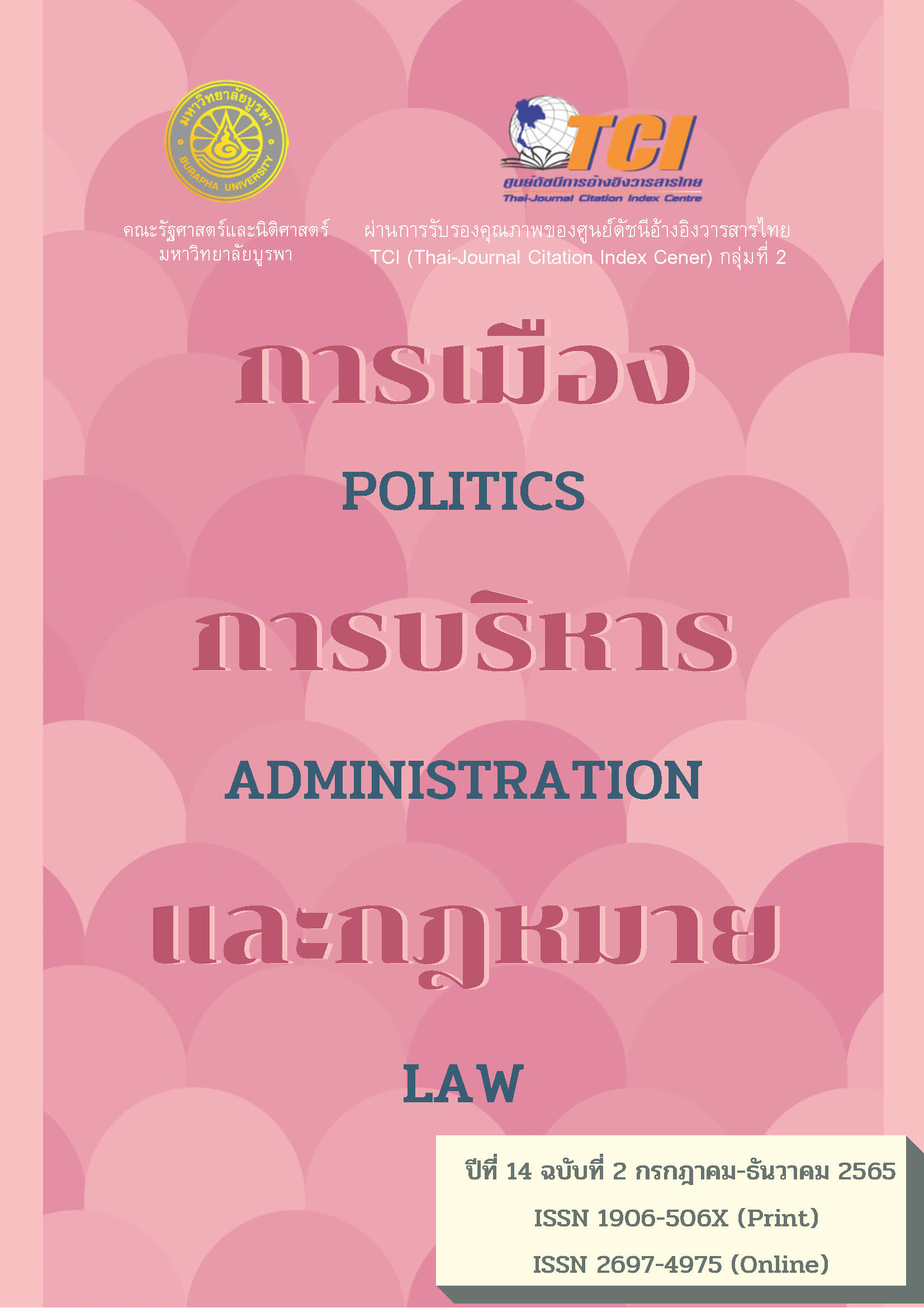Sustainable Eco - Industrial City Development: A Case Study of Laem Chabang City Municipality Chonburi Province
Keywords:
Sustainable development, Eco industrial townAbstract
A research on the development of an Eco-industrial Town : A case study of Laem Chabang Municipality, Chonburi. The purpose of this research is to 1. examine the public opinion level on the development of an Eco-industrial Town : A case study of Laem Chabang Municipality, Chonburi. 2. investigate the problems and difficulties on the development of an Eco-industrial Town : A case study of Laem Chabang Municipality, Chonburi. 3. present the guidelines on the development of an Eco-industrial Town : A case study of Laem Chabang Municipality, Chonburi. The researchers have studied the sustainable development of an Eco-industrial Town with the content which covers 5 dimensions including 1. Physical dimension, 2. Economic dimension, 3. Environmental dimension, 4. Social dimension and 5. Management dimension. The first result : According to purpose number 1, the survey result of the public opinion level on the development of an Eco-Industrial Town has found that the physical dimension is overall uncertain with an average of 3.04, the economic dimension is overall uncertain with an average of 2.73, the environmental dimension is overall uncertain with an average of 2.75, the social dimension is overall uncertain with an average of 2.74, and the management dimension is overall uncertain with an average of 2.64, respectively. The second result : According to purpose number 2, the problems and difficulties on the development of an Eco-industrial Town reveal that in the physical dimension, the traffic jam and the degraded nature are the biggest problems. In the economic dimension, the lower income of the community and the registered population have been taken jobs from the non-registered population are the biggest problems. In the environmental dimension, the degraded nature, dust, and pollution are the biggest problems. In the social dimension, having more non-registered population and less interaction in the community are the biggest problems. In the management dimension, lack of participation and the public confidence has decreased are the biggest problems. The third result : According to purpose number 3, the guidelines on the development of an Eco-industrial Town with the strategies for the sustainable development of an Eco-industrial Town are 1. The potential development of officials and community leaders, 2. Suggesting guidelines for industrial development in the area along with improving other dimensions, 3. Bringing back public confidence, and 4. Collecting all the problems and needs from the community and finding a solution together.
References
กรมโรงงานอุตสาหกรรม. (2558). คู่มือความรู้เกี่ยวกับอุตสาหกรรมเชิงนิเวศ. กรุงเทพฯ: สำนักส่งเสริมการมีส่วนร่วมของประชาชน กรมโรงงานอุตสาหกรรม.
กรมควบคุมมลพิษ. (2564). สถานการณ์คุณภาพสิ่งแวดล้อมของประเทศไทย ปี 2563. วันที่ค้นข้อมูล 16 ธันวาคม 2564, เข้าถึงได้จาก https://www.pcd.go.th/pcd_news/11873/
กรมโรงงานอุตสาหกรรม. (2562). เกณฑ์และตัวชี้วัดการเป็นเมืองอุตสาหกรรมเชิงนิเวศ ฉบับปรับปรุง ปี พ.ศ. 2562. กรุงเทพฯ: กองพัฒนาอุตสาหกรรมเชิงนิเวศ กรมโรงงานอุตสาหกรรม.
กระทรวงอุตสาหกรรม. (2554). แผนแม่บทการพัฒนาอุตสาหกรรมไทย พ.ศ. 2555-2574. กรุงเทพฯ: กระทรวงอุตสาหกรรม.
กรมโรงงานอุตสาหกรรม. (2562). เกณฑ์และตัวชี้วัดการเป็นเมืองอุตสาหกรรมเชิงนิเวศ ฉบับปรับปรุง ปี พ.ศ. 2562. กรุงเทพฯ: กรมโรงงานอุตสาหกรรม.
กรมโรงงานอุตสาหกรรม. (2562). แผนแม่บทและแผนปฏิบัติการการพัฒนาเมืองอุตสาหกรรม เชิงนิเวศ (Eco Industrial Town). วันที่ค้นข้อมูล 16 ธันวาคม 2564, เข้าถึงได้จาก http://ecocenter.diw.go.th/images/Download_Document/61-64.pdf
การนิคมอุตสาหกรรมแห่งประเทศไทย. เมืองอุตสาหกรรมเชิงนิเวศ (Eco-Industrial Town). วันที่ค้นข้อมูล 16 ธันวาคม 2564, เข้าถึงได้จาก https://old.ieat.go.th/old.ieat.go.th/eco
นิตญา สุทธาวาส. (2563). แนวทางการพัฒนาเมืองอุตสาหกรรมเชิงนิเวศพื้นที่ตำบลหน้าพระลาน. การค้นคว้าอิสระหลักสูตรวิทยาศาสตรมหาบัณฑิต, สาขาการจัดการสิ่งแวดล้อม, คณะบริหารการพัฒนาสิ่งแวดล้อม, สถาบันบัณฑิตพัฒนบริหารศาสตร์.
วิลาวัณย์ เอื้อวงศ์กูล. (2542). ความสัมพันธ์ระหว่างพัฒนาการของเมืองกับการเปลี่ยนแปลงทางวัฒนธรรม กรณีศึกษา เมืองเรณูนคร. วิทยาพนธ์ปริญญามหาบัณฑิต}, จุฬาลงกรณ์มหาวิทยาลัย.
วิสาขา ภู่จินดา. (2561). การจัดการสิ่งแวดล้อมตามหลักนิเทศวิทยาอุสาหกรรม. กรุงเทพฯ: สถาบันบัณฑิตพัฒนบริหารศาสตร์.
สมชาย มุ้ยจีน. (2559). แนวทางการพัฒนาเมืองอุตสาหกรรมเชิงนิเวศในเทศบาลเมืองมาบตาพุด. วารสารการจัดการสิ่งแวดล้อม, 12(2), 24-41.
เทศบาลนครแหลมฉบัง. (2559). แผนพัฒนาท้องถิ่นสี่ปี (พ.ศ. 2561-2564) เทศบาลนครแหลมฉบัง. ชลบุรี: เทศบาลนครแหลมฉบัง.
เอกลักษณ์ ณัถฤทธิ์ และพรทิพย์ พันธุ์ยุรา. (2564). แผนสิ่งแวดล้อมชุมชนเพื่อการจัดการคุณภาพสิ่งแวดล้อม เขตพื้นที่พัฒนาอุตสาหกรรมเชิงนิเวศ พื้นที่เทศบาลนครแหลมฉบัง อำเภอศรีราชา จังหวัดชลบุรี. วารสารด้านการบริหารรัฐกิจและการเมือง, 10(1), 74-91.
แผนพัฒนาเศรษฐกิจและสังคมแห่งชาติ ฉบับที่ 12 (พ.ศ.2560-2564). (2559, 30 ธันวาคม). ราชกิจจานุเบกษา. เล่ม 133 ตอนที่ 115 ก. หน้า 1-215.
WCED. (1989). Our Common Future (4th ed.). London: Earthscan Publication Ltd.
Downloads
Published
Issue
Section
License

This work is licensed under a Creative Commons Attribution-NonCommercial-NoDerivatives 4.0 International License.






